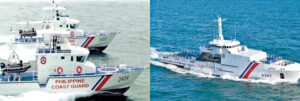As an archipelago composed of 7,107 islands and strategically located as the gateway to Asia, the Philippines is surrounded by vast seas and valuable resources that it must utilize to develop and boost its economy. With the constant threat of monsoons and typhoons along with the looming tensions in the West Philippine Sea, the country’s maritime capabilities are often tested.
The Department of Transportation (DoTr), tasked to take on the challenge of protecting the country’s waters and developing the maritime workforce, has worked on several projects to realize President Ferdinand “Bongbong” Marcos, Jr.’s dream, for the country to be a “global maritime hub,” as he stated during his second State of the Nation Address in July last year. In the previous year, the DoTr completed nine major projects in different parts of the Philippines that were financed by loans and foreign aid from South Korea and Japan.
The first of these is the Philippine Ports and Coast Guard Capability Development Project formerly known as the Greater Manila Access (GMA) Modular RoRo Ports Project. This involves the acquisition of four brand new units of 24-meter patrol boats along with one unit of 82-meter patrol boat worth P5.142 billion collectively for the Philippine Coast Guard (PCG).
The second project aimed to improve the capabilities of the PCG to quickly respond to maritime incidents and unforeseen circumstances. The first phase of the Maritime Safety Capability Improvement Project for the Coast Guard involves the acquisition of 10 44-meter Multi-Role Response Vessels (MRRVs) while the second phase encompasses the procurement of two 94-meter MRRVs. The purchase of the response vessels was sourced from the Japan International Cooperation Agency (JICA) and was bought for P9.267 billion and P8.017 billion, respectively.
Thirdly, the DoTr envisioned providing a modern international container port facility needed to sustain and further Cebu’s maritime development. The Philippine Ports Authority, quoting Drewry Maritime Research, noted that the port of Cebu was the 13th most effective seaport in Southeast Asia in 2022. The government agency’s program, the New Cebu International Container Port Project, aims to better these statistics and facilitate faster transactions in the Queen City of the South’s sea hub.
Construction is yet to start for the new port in Consolacion, Cebu. However, funding for the P9.962-billion program has already been secured and sourced through Official Development Assistance as recommended by the Korean International Cooperation Agency (KOICA).
The DoTr’s Economic and Social Development Program called for the procurement of fast boats and anti-terrorist equipment that will enhance the competence of the PCG in the performance of its vital functions such as maritime safety, maritime security, and maritime law enforcement. The equipment and vessels were worth ¥600 million in total and were funded through JICA grant aid.
Another endeavor that the agency completed last year was the acquisition of seven maritime disaster response helicopters. Just like the second project, the new choppers are meant to enhance response capabilities, particularly during maritime incidents, natural disasters such as typhoons, and calamities, with an estimated project cost of P5.846 billion. The program also includes training for pilots and technical crew who will be using the aircraft.
Additionally, the DoTr is also working on the Central Spine Roll-on Roll-off (RoRo) Development Project. The endeavor could potentially provide the Philippines with an efficient “spine” to facilitate the safe and speedy movement of passengers, vehicles, and goods between the Luzon Island-Panay-Negros-Cebu-Bohol-Mindanao zone. Once the project is completed, these areas will be connected by a highway system and RoRo ferry services with matching port and terminal facilities.
Moreover, the DoTr’s Maritime Safety Enhancement Project aims to improve aid-to-navigation technician capability, develop maritime traffic routes through safe facilities, acquire international standards, prevent maritime accidents, and lessen pollution in the sea. The project involves the acquisition of two buoy tenders and the construction of two buoy bases which will be used in the implementation of the program.
Completing this list of accomplishments last year is the acquirement of 40 Filipino-made 15-meter patrol boats last Oct. 17. Announced by Mr. Marcos during the 122nd anniversary of the PCG in Manila, the patrol crafts will give increased capability and are intended to help the Coast Guard perform its function.
Aligned with the administration’s vision to upgrade and strengthen the country’s maritime capacities, the President was quoted as saying in a report from the Philippine Star, “We are continuing with the upgrading of the equipment, the training, and the capabilities of all our people, especially the coast guard, not only because they are in the frontline (of) the problems that we are facing in the West Philippine Sea, but also because of the very important function that they play when it comes to search and rescue, (and) maritime incidents when it comes disaster assistance.”
Aside from these major projects, there were also a total of 32 completed locally funded maritime projects from 2022 up to October last year. 21 of these projects were finished in 2022 while 11 were implemented last year. These programs involved civil works such as the construction/rehabilitation of causeways and seawalls, the construction of access roads, and other port improvements all over the country.
Recently, the President ordered the Maritime Industry Authority (MARINA), another government agency under the DoTr, to standardize maritime systems in the country and bring them in line with international standards. This is in light of the European Commission’s decision to continue honoring the certificates issued by the Philippines to Filipino seafarers even as it has previously found that seafarer training in the country was deficient.
Presently, three maritime projects are ongoing, and 89 are Memorandum of Agreement-implemented projects. — Jomarc Angelo M. Corpuz
